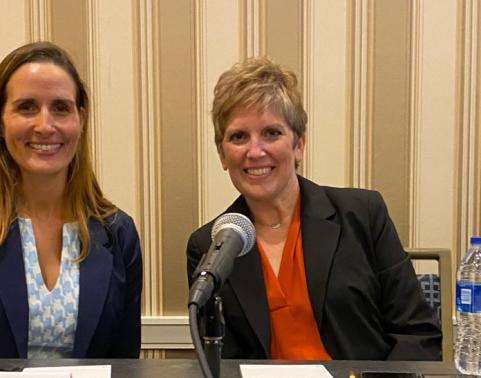Women Leaders at EIS Share Career Stories, Advice at AFCEA Belvoir Industry Days

Jennifer Potts and Nancy Richardson — both deputy project managers at PEO EIS — have educational backgrounds in science, technology, engineering and mathematics, but their personal journeys and career paths have put them on different trajectories to success.
During the “Women in AFCEA - IT Excellence and Leadership Panel,” held Nov. 4 at AFCEA Belvoir Industry Days, Potts and Richardson discussed how they came to be strategic users of data and some general tips for successful career advancement and work/life balance.
For Richardson — an engineer by education who is the second in command at EIS’s Defense Communications and Army Transmission Systems — 23 years of experience working with the medical supply chain at the Defense Logistics Agency helped her evolve from a “consumer of data to an enabler of data.”
“One of the biggest challenges today is taking what can be exceptionally complex topics and distilling them down in a way that they become consumable and understandable,” said Richardson.
The problem isn’t a lack of data, she added, but the need to ensure that it’s accurate and understandable to various stakeholders. “If you can’t distill it and make it meaningful to them, you won’t get through to them,” she said.
Potts, whose educational and early career background is in aeronautical science and Army aviation, joined EIS a few years ago and became the deputy project manager of the Army Data and Analytics Platforms (ARDAP) office in 2019, despite not having an information technology (IT) background. She credits “always being a student of what you do” for her successful career transition.
“I’m not an IT expert, so I ask a lot of questions,” said Potts. “I’m a student of information.”
Potts went on to explain ARDAP’s key role in addressing the Army’s data challenges and emphasized the importance of data access. She provided a real-world example: “When I log into my bank account, I need to know that money is there, so I can make decisions based on what my account is telling me,” she said. “Similarly, In the Army, we need to be able to get to data and make it meaningful to the user. If we can’t access it, we can’t trust it or know that it’s accurate.”
Asked for tips that leaders can provide to aspiring female IT professionals, Richardson recommended giving meaningful, actionable advice — like figuring how what they are both good and not so good at — instead of telling them to pursue their passion. She also advised that leaders tell mentees to “go out and do things that might steer you to something different,” noting that her early career role in project management at DLA led to later positions in acquisition and contracting.
“Progression is not just moving up; it’s looking side to side,” said Richardson. “When you do that, you can sort out your hard skills, like cyber or contracting, and your soft skills, like how well you work under pressure.” Richardson noted that taking the time to conduct this assessment gave her the opportunity to focus on the personal side of her life, raising three daughters while continuing to work, without feeling overwhelmed or that she had to make sacrifices.
Potts, a longtime military spouse, said that some sacrifices were necessary in her case to enable her family to pursue careers while remaining closely connected. Noting that the Army has done “a phenomenal job of allowing spouses to be part of the civilian workforce,” Potts said that she and her family have always made career decisions together.
“Success should be personal,” she said. “Make decisions with people who matter, and don’t worry what others say … Sometimes you can take a knee for your personal needs.”
Potts also advised having good mentors and battle buddies. “Build a network of people you trust” based on what you can learn from them, she said. That network may include both men and women.
Despite working in different portfolios and mission areas at EIS, Richardson and Potts have found dependable battle buddies in each other. “Nancy is a good sounding board,” said Potts.
Other participants in AFCEA’s “Women in IT” panel included Nancy Kreidler, director of cybersecurity and information assurance for the Deputy Chief of Staff, G-6; Col. Maritza Lagares, executive officer to the Army Chief Information Officer; and Natalie Pittore, chief of the National Security Agency’s Security Framework. Mollie Pearson, president of Pearson Consulting, moderated the discussion.
Related News
-
Onedia James: a logistician and leader with a family legacy of service
April 22, 2025Onedia James recently stepped into the role of acting deputy project manager for Army Data and Analytics Platforms (ARDAP) at U.S. Army Program Executive Office (PEO) Enterprise, where she helps oversee and support the data portfolio’s four programs. -
PEO Enterprise’s new PL Digital Market reimagines IT product/service procurement
April 2, 2025FORT BELVOIR, Va. – U.S. Army Program Executive Office (PEO) Enterprise today announced the launch of the Product Lead (PL) Digital Market, which replaces PL Computer Hardware, Enterprise Software and Services (CHESS), effective Apr. 2, 2025. -
Two vastly different Army programs prepare for Software Acquisition Pathway
March 24, 2025At U.S. Army Program Executive Office Enterprise, which is now over two years into its Agile transformation, several enterprise software programs are already in the execution phase of the DOD’s Software Acquisition Pathway, which is designed to facilitate rapid and iterative delivery of software capability to users.
Work for Us
Join a winning team! Search for job opportunities with PEO Enterprise.
Work with Us
Help support important missions. Explore ways your company can work with PEO Enterprise.